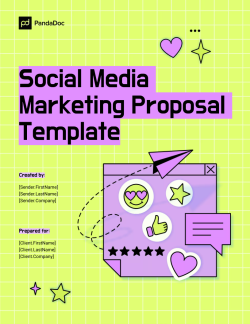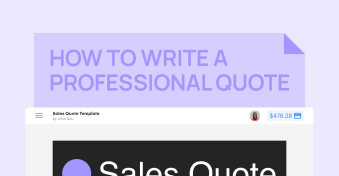Nothing speaks to a customer’s direct needs like a well-written business proposal.
Whether you want to land a new client, win a contract, or secure funding, the right proposal can make all the difference.
But how do you make sure that your proposal is engaging to every potential client and business owner?
In this guide, we’ll walk you through proven strategies, best practices, and step-by-step instructions to help you write business proposals that close deals.
Here’s a closer look at how to write a business proposal that actually works.
What you’ll learn
- Key components every proposal should include—from cover page to call to action
- Types of proposals (solicited vs. unsolicited, internal, formal, and informal) and when to use each
- A proven structure to follow, including real-world tips and examples.
- Best practices for writing proposals that are concise, persuasive, and visually engaging
- Expert insights backed by data from millions of documents sent through PandaDoc
- Practical tools and templates to streamline your workflow and increase your close rate.
By the end of this guide, you’ll know how to create customized, professional proposals that clearly communicate value, solve client problems, and help you stand out from the competition.

→DOWNLOAD NOW: FREE BUSINESS PROPOSAL TEMPLATE
Our data: the breakdown
The insights in this article are compiled from our analysis of nearly 7 million documents that were sent through the PandaDoc platform.
Here’s a quick list of the most popular proposal and document types that were sent through our systems:
- NDA Template
- Social media marketing proposal
- Digital marketing proposal
- Software development proposal
- Business proposal (generic)
- Marketing proposal (generic)
- Grant proposal
- Sponsorship proposal
Similar proposals of various types were also sent in smaller numbers, along with a wide array of other sales documents.
Because PandaDoc is more than a proposal platform, the lion’s share of documents flowing through our platform are invoices, quotes templates, contracts, and similar business collateral.
Proposals represent a small but essential segment of business documentation.
Other insights
While we were analyzing proposals and business documents, a few other statistics stood out to us.
- The average creation time for proposals dropped significantly when using automation tools like templates and the content library.
- The addition of an e-signature block made no significant difference in proposal creation time.
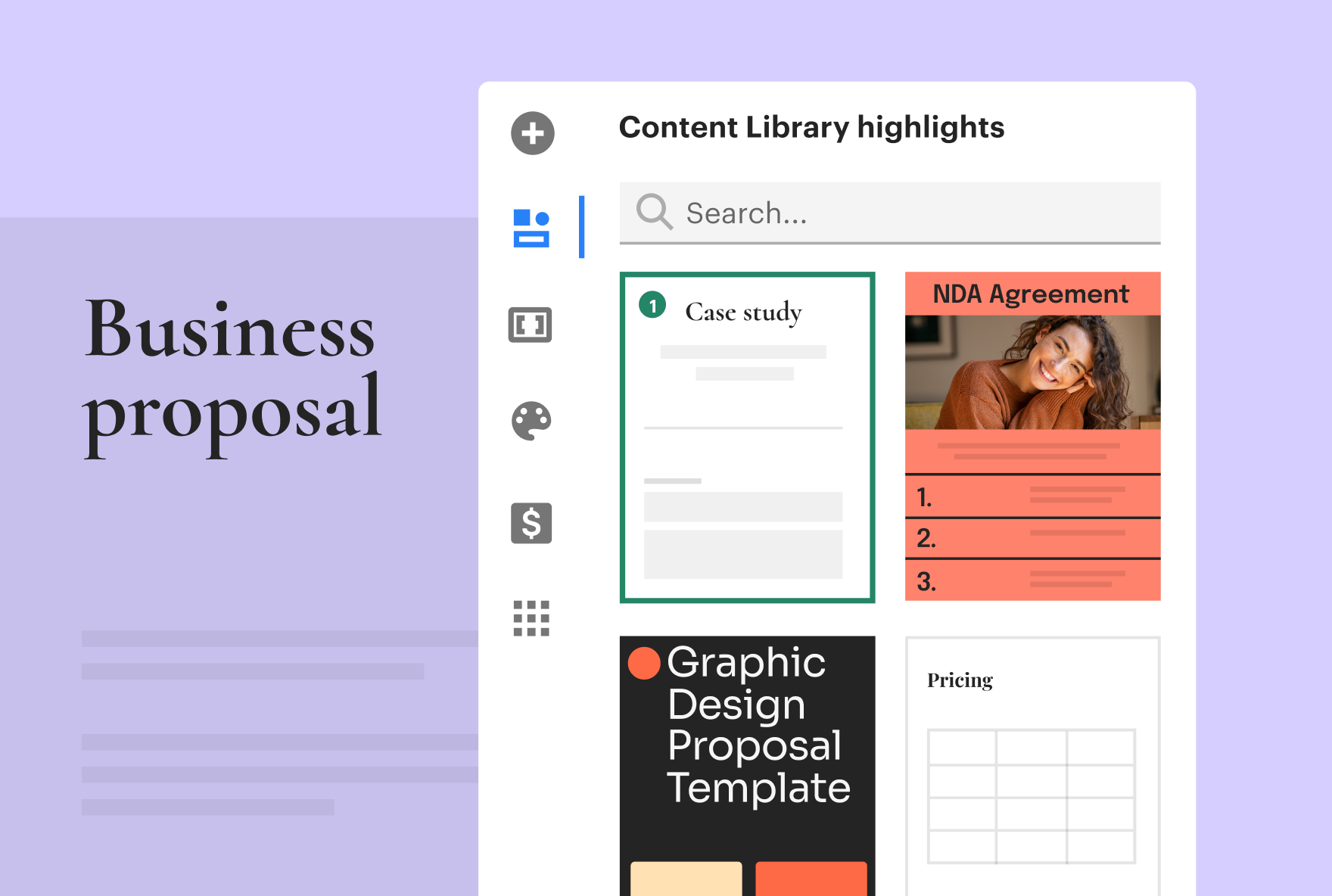
Business proposals are essential sales collateral in the business world. You’ll need one if you’re selling complete and/or complicated solutions.
Business proposals: the basics
This section provides an overview of business proposals, including an in-depth explanation of what they are and why you may need them.
While the technical specifications required for a proposal vary between industries, the basics of how a proposal is intended to function are essentially the same.
We’ll cover the parts of a business proposal in the next section, so if you’re already familiar with the basics, feel free to skip ahead.
What is a business proposal?
A business proposal is a formal document that outlines a specific product, service, or project that a company offers to potential clients, partners, or investors. Its purpose is to persuade the recipient that your business can meet their needs better than a competitor.
Proposals vary widely depending on the industry, client, and scope. For example, a digital marketing proposal may be short and focused on campaign goals, while a construction proposal might be extensive, covering blueprints, permits, and phased timelines.
Strong proposals typically include:
- An introduction and value proposition
- Scope of work or deliverables
Pricing or budget
Timeline and milestones
Terms and FAQs
Why are business proposals important?
Business proposals are important because they help companies win work, secure funding, and build professional relationships. They clearly explain how your product or service solves a specific problem, making it easier for clients, investors, or stakeholders to say yes.
Here’s why they matter:
- Win new clients: A strong proposal can help turn interest into a signed deal
- Show your value: Clearly explain your solution and why you’re the right choice.
- Secure funding: Investors want to see a clear plan, and proposals help them understand the opportunity and potential
- Get project approval: Internal teams use proposals to decide if a project makes sense and aligns with goals
-
Set clear expectations: Proposals outline the scope, budget, and timeline, ensuring everyone’s on the same page
Build trust: A well-organized proposal shows you’re prepared, professional, and understand the client’s needs - Stand out from competitors: In a competitive space, an excellent proposal helps you make a lasting impression.
What is the format of a business proposal?
Most business proposals follow a similar structure, typically including:
- Introduction
- Problem statement or needs analysis
- Proposed solution
- Scope of work
- Timeline
- Pricing
- Terms and conditions
- Call to action
How long should a business proposal be?
According to data from proposals created on the PandaDoc platform, the average proposal is around nine pages.
However, length can vary based on:
- Industry: More technical industries like construction or home repair often require longer proposals.
- Deal size: More simple transactions typically have shorter proposals.
Expert tips: shorter is better
“Short and sweet has a high conversion rate, fewer pages, and less fluff is better. Ideally, a proposal should be fewer than 10 pages for transactional proposals below $10,000, and never more than 50 pages.”
- –Josh Gillespie, Upmarket Sales
Artyom Voronetskiy, former Account Executive with PandaDoc, agrees: “Keep it short, on-point, and eye-catching. Do not write more than 6-10 pages unless your product is extremely complicated.”
Include only what’s necessary for decision-making and avoid overcrowding your proposal with irrelevant or excessive detail.
For a step-by-step walkthrough on building your proposal, continue to the next section.
What are the different types of business proposals?
Business proposals can take several forms, depending on their purpose and how they’re initiated.
Understanding the type of proposal you’re writing is crucial—especially when responding to a Request for Proposal (RFP), which often includes strict formatting and content requirements set by the issuing organization.
Here’s a breakdown of some of the most common types of proposals.
Solicited business proposals
These are the proposals you’re asked to submit, meaning the client has already expressed interest and wants to hear from you.
There are two types of solicited proposals:
- Formally solicited proposals. These are usually part of a structured, competitive process. The client sends out an RFP, often with strict guidelines on scope, format, deadlines, and deliverables.
-
Informally solicited proposals. These are more informal and typically come after a conversation or meeting. Maybe a potential client asks you to send over a proposal after a discovery call. There’s no official RFP, and it may not be a competitive situation. These often lead to sole-source (non-competitive) deals.
Unsolicited proposals
Unsolicited proposals are the pitches you send without being asked. Think of them as cold pitches, where you identify a need or opportunity the prospect hasn’t formally requested help with (and might not even know they have).
These can be highly effective when:
- You’re offering something timely or innovative
- You’ve done the research and understand their pain points
- You personalize the proposal to show value upfront
While solicited vs. unsolicited covers the basics, there are a few more proposal types worth mentioning:
- Formal vs. informal: Some proposals follow strict formats (especially in corporate or government settings), while others are more flexible, especially in small business or startup environments.
- Internal proposals: These are created for decision-makers within your own company. They’re often used to pitch a new initiative, request budget, or propose a process change.
- Ongoing vs. one-off proposals: Some proposals aim to secure a long-term engagement or retainer. Others are just for a one-time project.
What key elements should be included in a business proposal?
Besides following a basic format, an effective business proposal should include a few essential elements to make it clear and persuasive.
- Title page. Includes your company name, proposal title, client’s name, and the date.
- Executive summary. A brief overview of the proposal: what you’re offering, why it matters, and the key benefits.
- Problem statement. Defines the client’s specific challenge or need, showing you understand their situation.
- Proposed solution. Explains your product, service, or approach and how it solves the client’s problem.
- Scope of work. Outlines exactly what you’ll deliver, how, and when, including any phases or milestones.
- Proposed timeline. Details the project schedule, including key dates or deadlines.
- Pricing and budget. Breaks down costs, payment terms, or pricing packages. Be as transparent and specific as possible.
- Company info /qualifications. Includes background info, experience, case studies, or client testimonials that build credibility.
- Terms and conditions. Covers legal or contractual details like payment terms, confidentiality, or cancellation policies.
Call to action and next steps. Informs the client on the next steps to take. This could be signing, scheduling a meeting, or contacting you.
How to write a business proposal
Writing a business proposal is like building a house.
While certain elements are always necessary — like the foundation — some components vary based on location and the architect or homeowner’s preferences.
In the same way, the components of a business proposal can vary based on industry, company size, and many other factors.
Just like writing anything else, a well-written proposal begins by gathering information and assessing the problems that your potential client is trying to solve.
When writing a business proposal, the following items are what readers are looking to understand. Think of these as the roof, walls, and foundation of your document:
- Information about your company. Your background, your qualifications, and why you’re a better fit than the rest of your competitors.
- Demonstrated knowledge of the problem. Proof that you’ve listened and done your research. You know what the client needs and you have a viable solution.
- Pricing and methodology. How you plan to solve the client’s problem, information about your proposed solution, and how much it’s going to cost.
In this section, we’ll take you through how to write a business proposal using a modified version of social media proposal template as an example.
If you’re not a social media company, don’t worry.
While the business proposal template we’re using is an example of a simple project proposal, the basic structure applies to nearly every business proposal — no matter how complex they might be.
You can download this business proposal example or other business proposal templates on our website.
Here are the main elements of a business proposal.
How to write an outline for a business proposal
A standard proposal outline typically includes most or all of the following elements:
- Title page.
- Cover letter.
- Table of contents.
- Executive summary.
- Proposal & solutions pages.
- Pricing.
- About us.
- Testimonials & social proof.
- Agreement & CTA.
However, this won’t always be the case. Shorter projects and abbreviated formats may not call for every single section.
When creating your business proposal, you should include everything you believe you need in order to sell your product or service to your prospective customer.
This usually includes the sections above, as well as any supplemental documentation to justify your costs and reinforce your proposed approach to solving the client’s problem.
If you’re sending your proposal electronically, you should also consider including an electronic signature block so that decision makers can quickly and easily seal the deal when they’re ready to proceed.
In addition to basic information about your product/service, you may want to include the following:
- Contact information.
- Value statements.
- Pricing tables.
- Client testimonials.
- Examples of past work (case studies).
- Images, graphics, and related multimedia.
To save time, gather this information before you start the proposal process.
Having this information on hand while building your proposal will make the process much easier.
Once you’ve got all the essential details and sales collateral you need, you’re ready to start creating your proposal document.
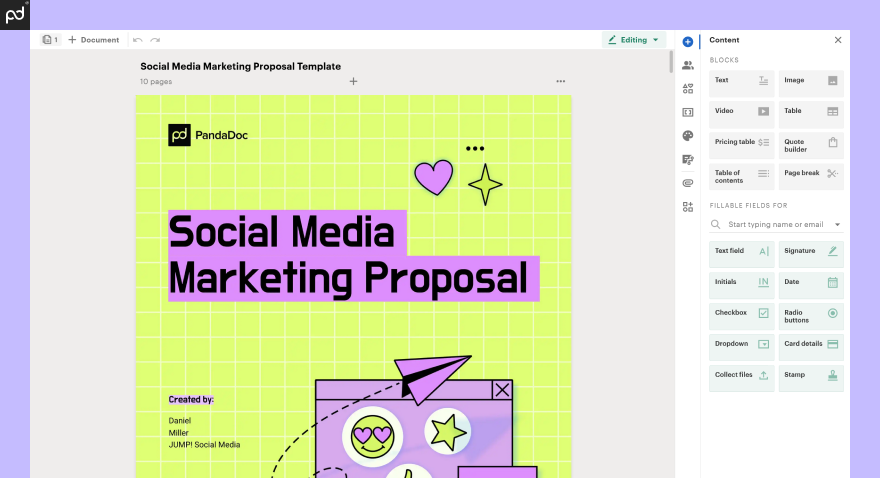
Many templates in the PandaDoc library feature fun, editable cover pages. We’re also integrated with Canva, if you want to take a hands-on approach to your layouts.
1. Create a cover page
This section of a business proposal includes basic information that your readers will need to understand the document and its content.
Consider including each of the following elements:
- Proposal title.
- Date of submission.
- Company information (company logo, company name, etc).
- Your name, title, and contact information.
- Client’s name, title, and contact information.
A cover page is the very first thing that your prospective client will see when they open your business proposal.
Give them all the details they need to identify the document at a glance, and take the time to make it look good.
Everyone knows how important that first impression can be.
Studies have shown that you have as little as 50 milliseconds to make a good first impression when designing visual content like websites.
The same holds true for the cover page of your business proposal.
This page is a place where you can freely place graphics and visual content to set the tone before the reader dives into the meat of your presentation.
Variables make it easy to modify proposal items that will change each time you send your content and allow you to reuse the same document by swapping the variable values.
PandaDoc supports variables by default, but you can also create them manually and replace the text using the find/replace tool in your word processor.
However, you won’t need to go overboard with complicated graphics and logos.
Users love simple and familiar designs, especially at a first glance.
Spending time on this page is also a great way to give your proposal a unique look and feel.
Based on what we’ve seen, some businesses skip cover pages entirely.
However, we don’t recommend it.
Take advantage of this missed opportunity from your competitors and use it to make your proposal stand out.

A simple cover letter is a great introduction to your proposal document. Using template tools and variables, each letter can be customized in moments.
2. Introduce yourself with a cover letter
You wouldn’t walk up to your potential client and dive into project specifics without taking the time to introduce yourself, would you?
A cover letter is that introduction. Consider including each of the following:
- A short blurb about your company.
- A quick summary of your proposal.
- A reason that your approach is best.
- A signoff with your contact information.
This section is essential because it helps anyone reading the document understand your relationship to their organization and how the proposal came about.
With your business proposal introduction, keep the tone light and friendly and encourage your reader to reach out with any questions.
Sign off by including your contact details so that the client can get in touch directly if they need to follow up or would like to move forward.
Cover letters don’t need to run to the point of exhaustion. They can be simple, short, and sweet.
This page can take on many forms, and you can use that flexibility to make your cover letter easier to parse.
This example rephrases the text in the image above by using bullets to make the formatting more legible:
Dear [Client.FirstName]
Thank you for considering [Sender.Company] for your social media marketing needs.
Enclosed, you’ll find a proposal based on our understanding of your social media expectations. Briefly, we propose:
An expanded social media strategy across currently unused platforms and channels.
A comprehensive distribution strategy designed to generate original and unique content.
Improved post automation for increased audience engagement during peak times.
Our methods and procedures are based on extensive analysis, an intense study of social media trends, and the application of specifics unique to [Client.Company].
We are confident in delivering effective results within your social media channels.
Thanks again for considering us, and please don’t hesitate to get in touch with questions.
My contact information is below.
Lastly, in our initial example, you’ll also notice that we’ve used an image to keep things fresh and interesting.
This is critical throughout your proposal. In our research, we found that a business proposal with media like photos and videos included is 34% more likely to close.
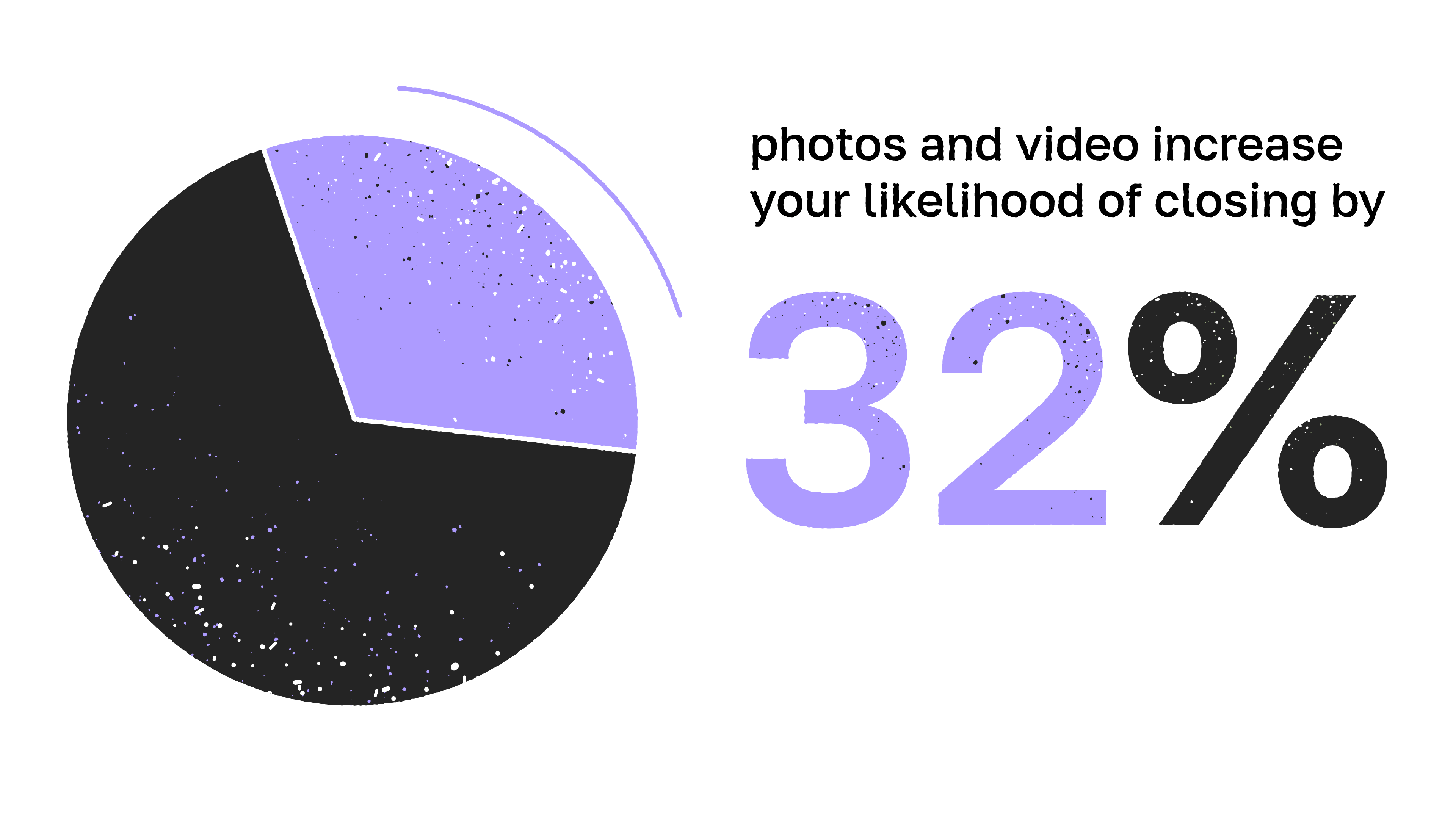
Including graphics and multimedia create visually appealing content that prompts engagement.
That’s huge!
As you’re making your proposal, don’t be afraid to add graphics and images to keep readers engaged.
A winning business proposal is more than just black text on a white page.
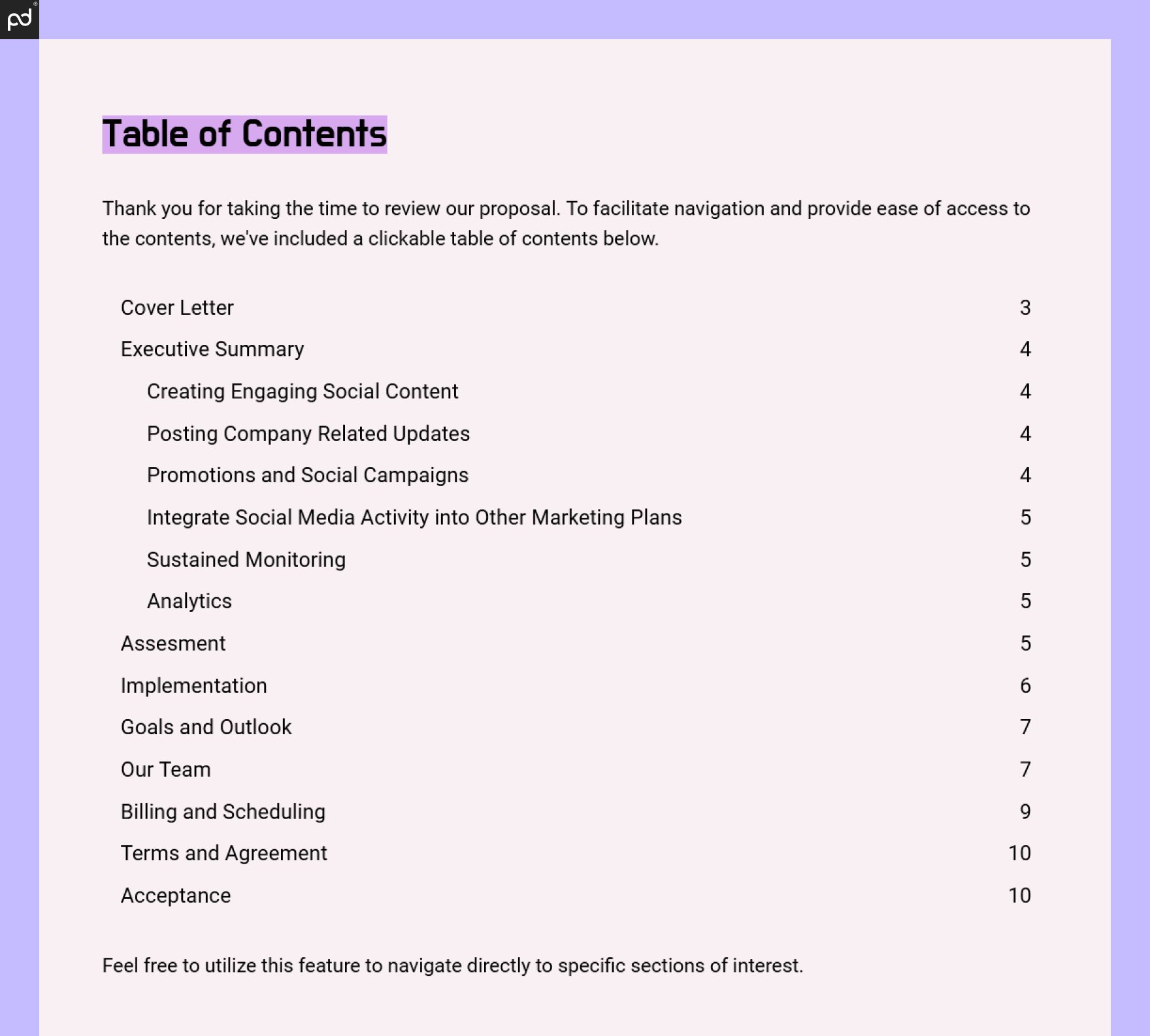
In a digital proposal, a clickable table of contents can make navigation easy. If you think the proposal will be printed, include page numbers for faster manual navigation.
3. Table of contents
A table of contents is an important, but often overlooked, part of any longer document because it helps the reader know what they can expect to find in the proposal.
Unless your business proposal is very brief, include a table of contents that outlines the basic structure of your document.
This element isn’t always necessary, but it can make a business proposal much easier to parse as your document is passed around to all appropriate parties.
How you want to approach this may vary, depending on the nature of the proposal and the client business.
Electronic documents
Electronic documents can benefit from a clickable table of contents.
Word processors typically generate these using the headings in your document.
Readers can click on them to jump to relevant sections without the need to navigate through multiple pages.
Physical documents
Physical documents will benefit from having page numbers associated with the table of contents since a business proposal PDF (hard copy) isn’t clickable.
Most word processors have an option to include page numbers in your table of contents, but make sure that you update the element when your document is complete in case the page numbers have changed.
Keep in mind that proposal documents may not be read chronologically.
Different decision makers will care about different things and will check your business proposal to see how it addresses their unique pain points.
Don’t lose a deal just because stakeholders couldn’t find what they were looking for!

The executive summary provides a high-level overview of your proposed solution and can be broken down with headings into multiple components.
4. Set the stage with an executive summary
The goal of an executive summary is to provide a holistic, high-level overview of your proposal, how it addresses the client’s problem, and its expected outcomes.
If you provided a few of these points in your cover letter, this is your opportunity to go into greater detail and summarize your overall strategy.
However, because this section needs to give a full overview, it’s difficult to write if you haven’t created the rest of your proposal.
For this reason, experienced proposal writers often write this section last.
Don’t get lost describing deliverable logistics or strategic plans.
Focus on the client’s needs and the outcomes they specifically wanted to address in their RFP.
Let your executive summary present a high-level overview and leave the other pages of the document to explain the details.
This will prevent your summary from getting overcrowded or bogged down with specifics best handled elsewhere.
Using the example in our social media proposal template, let’s pretend that our potential clients are primarily realtors in the greater Chicago area looking to reach new clients through social media marketing.
With that in mind, we could modify the executive summary in the existing template to something like this:
This proposal outlines a coordinated plan crafted with the intent of building [Client.Company]’s social media presence, primarily including Facebook, Instagram, YouTube, TikTok, and X (Twitter).
By engaging an audience through social media channels, our team will demonstrate the ability to generate awareness, widen your company’s potential reach within your target market, and contribute to driving more website traffic, which will ultimately result in top-line growth.
We help teams identify, target, and communicate with their ideal clients through each of the following:
1. Creating engaging social content.
2. Posting company-related updates.
3. Promotions and social campaigns.
4. Integrating social activity into marketing initiatives.
5. Sustained monitoring.
6. Analytics & reviews.
While our competitors work to serve multiple industries and target audiences, we specialize in the [Client.Industry] industry. Founder Mike Smith also has a background in both social media and [Client.Industry], giving him a unique perspective on the needs of the market.
Your own executive summary and the tone you use to address problems may shift depending on the duties you’re performing for your client, and what kind of industry they’re in.
For example, if you’re targeting a young travel startup run by new college graduates, you might use a more casual tone peppered with industry jargon and humor.
By contrast, a group of C-level executives might prefer a more formal summary styled with specific metrics and numbers.
Keep your audience in mind as you write this section and demonstrate that you understand what they’re trying to achieve.
Remember: The executive summary previews the rest of the document. If your summary fails to address reader concerns, your proposal may be discarded without a full review.

Make sure your approach is clear. Tables and other visual aids are useful when summarizing your solution.
5. Proposal and solutions pages
The proposal section is the heart of your entire document.
In this section, you’ll need to fully present the solution your company has devised for a potential client.
This section should do each of the following:
- Provide a comprehensive breakdown of the solution your company has devised to solve a client’s problem.
- Tell readers exactly what deliverables they can expect and when they should expect them.
- Answer obvious questions that reviewers may have about your approach and/or methodology.
While you can write this section out in full paragraphs, visual aids can be extremely helpful in conveying critical information in a digestible way.
A timetable that pairs deliverables with their expected date can make your document more visually appealing, and your information much easier to parse.
You might also break down your main objectives even further by describing how you plan to execute a given strategy.
In our executive summary example (above), we touched on six key goals. Let’s expand on those here.
1. Creating engaging social content
Beginning with quick and thorough planning/preparation, our team will plan out a dynamic, ongoing social content calendar to guide you to your goals.
We will grow an increasing social audience and follower base using each of the following techniques:
- Hashtag campaigns.
- Strong use of keywords.
- Sharing/retweeting relevant news.
- “Liking” posts.
- Staying updated within the industry.
- Contributing our own unique content to broaden reach.
2. Posting company-related updates
Our plan is to engage your social media audience by sharing company news, press releases, events, employee spotlights, and more.
We will also pay attention to industry trends and share them.
This will help to gain exposure to your target market.
3. Promotions and social campaigns
We will utilize social channels to connect with your follower base and engage them with promotions to get them excited about both current events and the brand itself.
These campaigns may be as short as a day or run up to six months.
We’ll analyze the results from each campaign, and then we will provide a report of its success.
Results of campaigns can be compared so the most effective promotions, offers, or contests can be replicated.
4. Integrating social media activity into other marketing plans
With clear communication and monthly brainstorm meetings, we’ll be able to consolidate the marketing initiatives to fit your goals and promotional material.
Campaigns via social media are more important than just sharing about giveaways, sales, contests, and/or promotions.
We will agree on a schedule for a series of posts to keep up the exciting momentum for all prospective customers.
5. Monitoring
For maximum growth, it’s important to regularly engage with users on social platforms.
We will continually monitor each social channel and will respond to any questions, comments, and posts within a two-hour time period (during business hours).
A small delay will allow us to confirm that the information we relay to customers is accurate.
6. Analytics
We will provide you with each of the following:
- Daily and weekly analytics. Follower growth, reach, demographics, comments, “likes”, shares, retweets, and additional metrics as provided by each platform and our own internal tracking data.
- Reporting. Summarizing various results and activities over each quarter.
We will also set up a monthly meeting to go over the results and then tweak our approach accordingly.
Your own content may look different than this depending on your business proposal writing skills and services, but you can still use the example as a framework. Add in more details as needed.
For example, a cybersecurity company would need to include information on penetration testing and how often it would be done to look for possible intrusions and hacks.
Breaking up this section
While writing business proposal content, keep in mind that this section is both the most important and the most flexible section of all.
Your entire proposal doesn’t need to be bundled into a single, long section. It can easily be broken down into smaller sections such as:
- Strategic Assessment.
- Implementation.
- Goals & Outlook.
There are other combinations you can try, depending on your business proposal and how your solution should be explained.
If you’re offering a complex solution to a client problem, breaking your proposal into bite-sized chunks is a great way to ensure that readers understand your solution.
The importance of good data
Leveraging good data is critical when creating an effective business proposal.
Use details surrounding impact and ROI around your products and services to prove your worth and add value to your proposal.
Consider these two phrases:
- “Our customers love us!”
- “To date, our products and methodologies have helped more than 700 companies increase their sales by 35%!”
Which sounds better? Which is more compelling?
Numbers and figures catch the eye and help readers build trust.
By demonstrating a proven record of success, with numbers and data, you’re adding tangible details that help to justify your costs.
This is especially useful when competing with other solicited proposals, especially if you can include these data points as visual representations (charts, graphs, etc.) of your success within your proposal document.
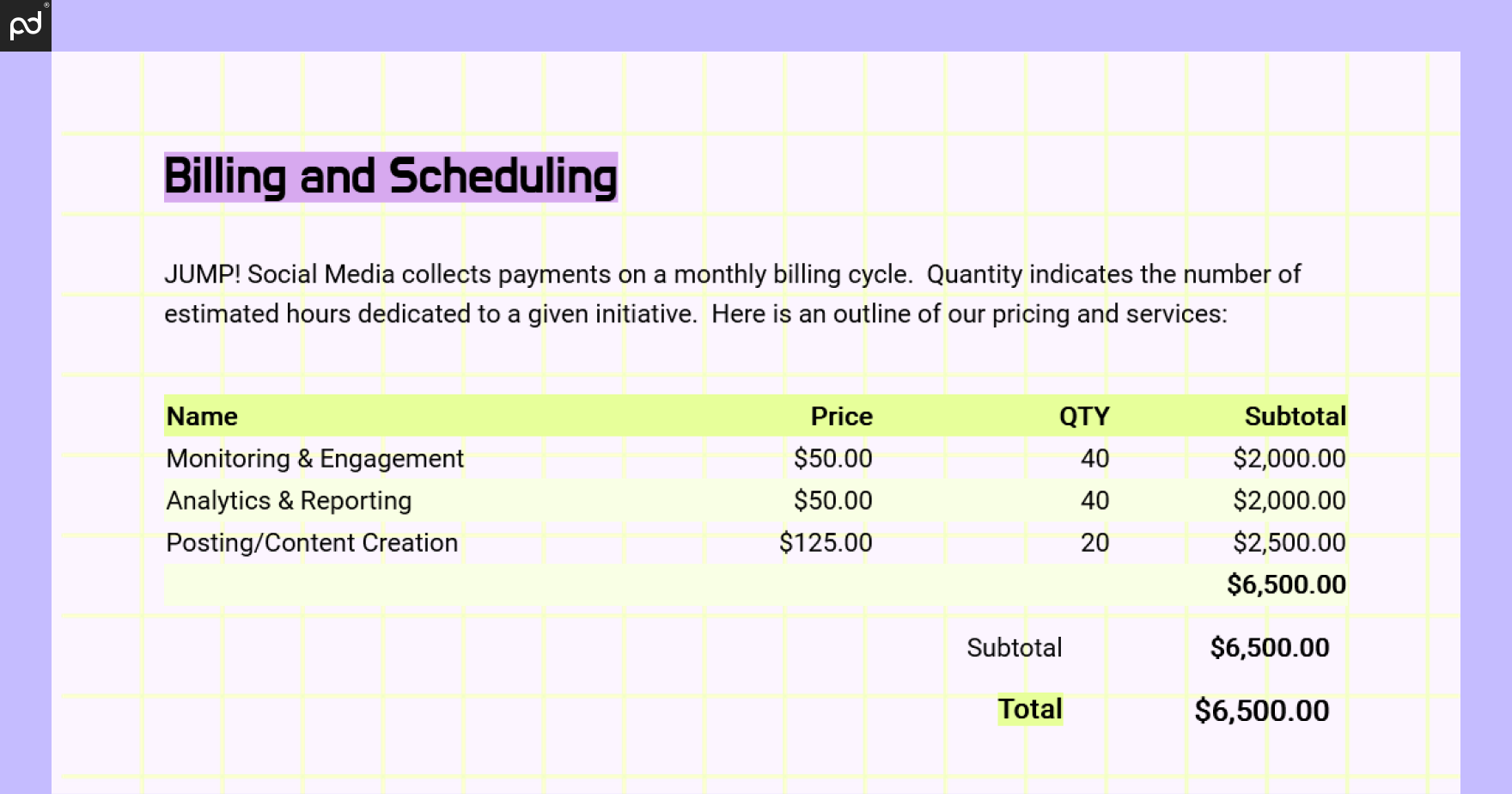
Providing totals as an itemized list or a package option are effective approaches to pricing.
6. Pricing
The pricing section explains how much it will cost the client for you to solve their problem.
In this section, you’ll need to do each of the following:
- Break down your proposed solution by cost.
- Indicate any product quantities as line items.
- Give package options (if applicable).
Regardless of your pricing structure, clarity and specifics are critical in this section.
To eliminate confusion, consider creating a pricing table that clearly identifies each product or service, and pair it with the most accurate pricing information you can provide.
With a dedicated table, all you’ll need to do is set the price for the item and the quantity of distribution.
If you were sending an hourly contract, the quantity is the estimated number of hours invested at a predetermined rate.
For recurring payment schedules, you’ll need to structure the document in a way that accurately reflects your monthly workflow.
Transparency is critical in this section.
Potential customers need to know how you’re charging them, what they’re being charged for, and what to expect in return.
Be sure to include these details in a clear and accurate way.
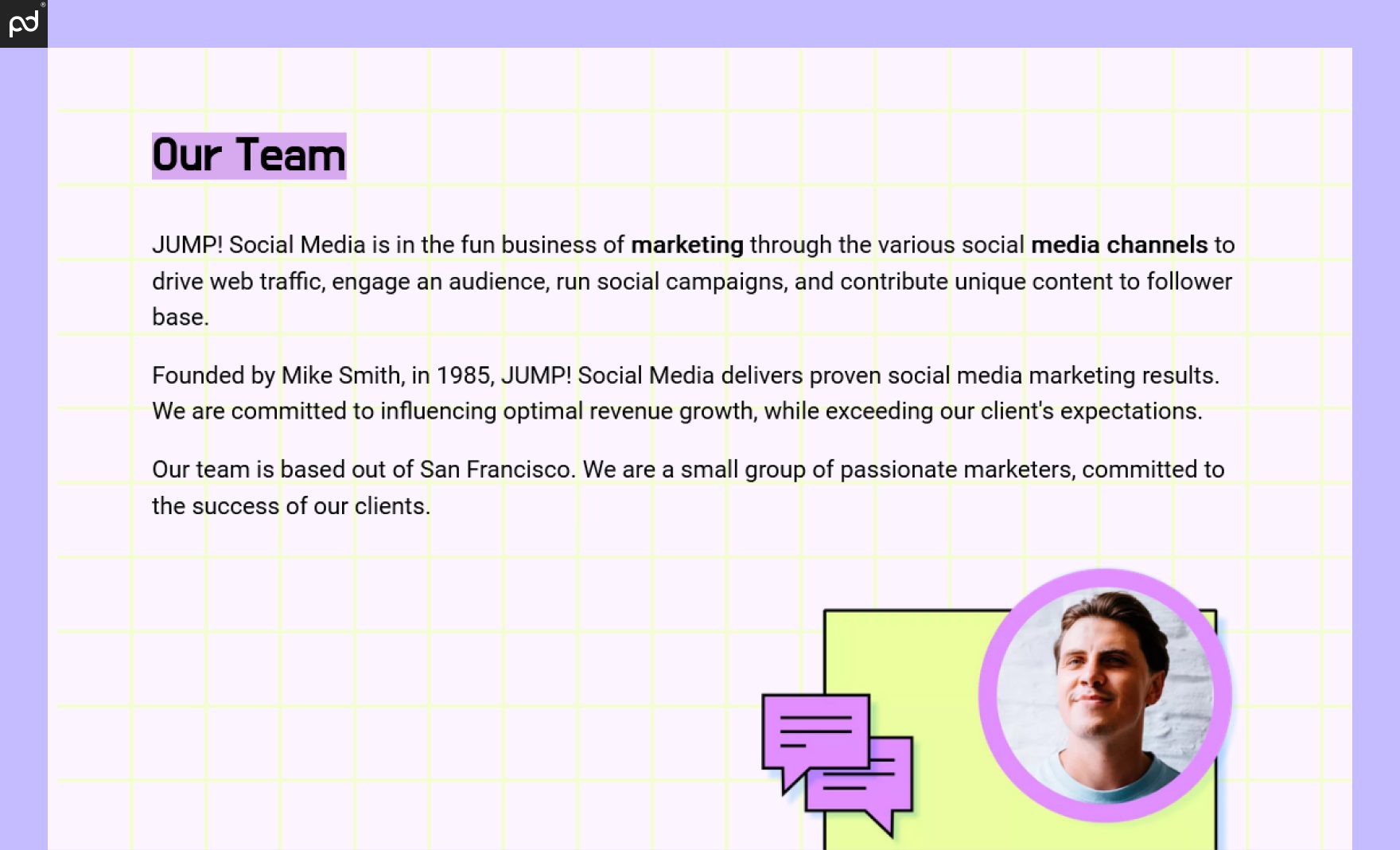
A biographical section can speak to years of experience, awards and accolades, and more.
7. About us
While you already said hello with the cover letter, this section is where you get to explain what makes your company unique.
If you’re a small business or a new company, get personal and give your potential client a chance to get to know you and your team members.
Consider including the following items:
- A brief summary of your business and its operations.
- Bios and photos of the individuals they’ll be working with.
- Relevant qualifications, certifications, or experience.
If your company has a unique backstory, a mission, or a cause that your company stands for, share that with readers. For example:
Too often in social media, good things come at a price. At Jump, paying for followers or favorable reviews of products is tantamount to criminal activity.
Authenticity is important in today’s online world, and Jump Social Media Marketing makes this our No. 1 priority in your social media space.
The information on this page doesn’t have to be a stodgy company boilerplate or a cleverly designed sales pitch.
Don’t be afraid to let your team’s personality shine through.
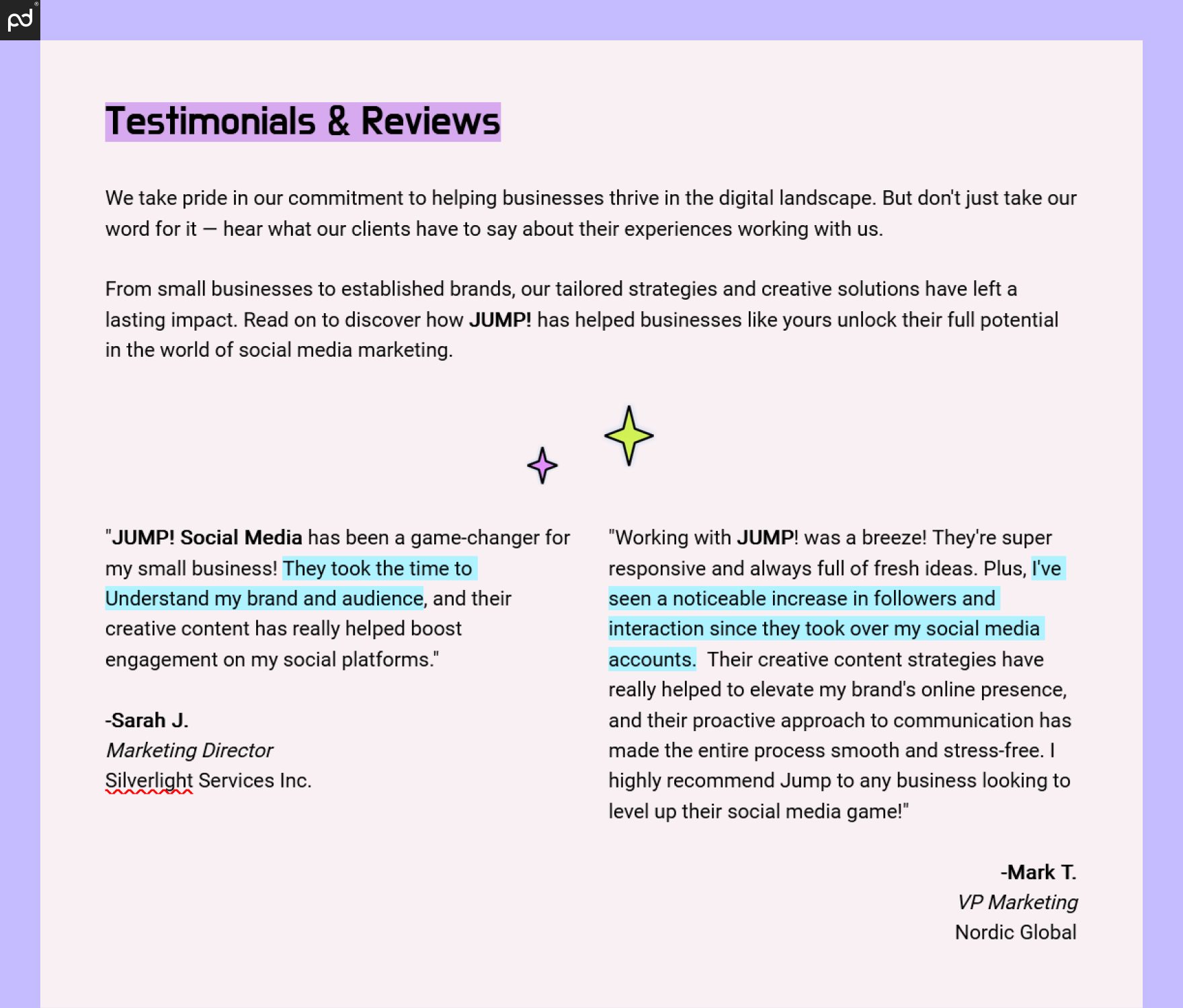
Glowing reviews and positive feedback can help prospective clients better understand how your organization delivers on your initiatives.
8. Testimonials and social proof
No sales proposal is complete without information about your past successes, awards, and jobs well done.
In a business proposal, this comes in the form of a social proof section, which might include:
- Past client testimonials.
- Case studies.
- Reviews and/or ratings.
- Industry awards.
Regardless of what you choose to include, don’t skip this section. Social proof matters!
According to data, over half of customers are more likely to trust earned media, like recommendations from friends and family, above all other forms of advertising.
By including recommendations from satisfied customers and industry awards that prove your expertise, you can earn additional trust from prospective clients.
Here’s a good example of how Jump Social Media Marketing might leverage the accolades they’ve received:
Jump Social Media Marketing has received major public recognition for our work.
We’ve been named as Chicago’s Best Social Media Agency for Small Businesses by the Chicago Tribune for the past three years and have been recognized as a recommended partner by the National Association of Realtors.
We also grew the Chicago Real Estate Solutions Facebook page from 0 to 5,000 in six months, secured 250 new leads in that time frame, with 25% converting to sales.
You can also provide testimonials from past clients who can speak to your approach and how it worked for them.
However, keep your industry in mind when compiling testimonials and do your best to find user feedback that fits the mood.
If your industry has serious clients, a humorous approach may not be appropriate.
If you’re working with a manufacturing company focused on B2B industries, the messaging and tone they take with their own clients — and what they expect from the businesses they work with — may follow different expectations.
Be sure to plan accordingly.
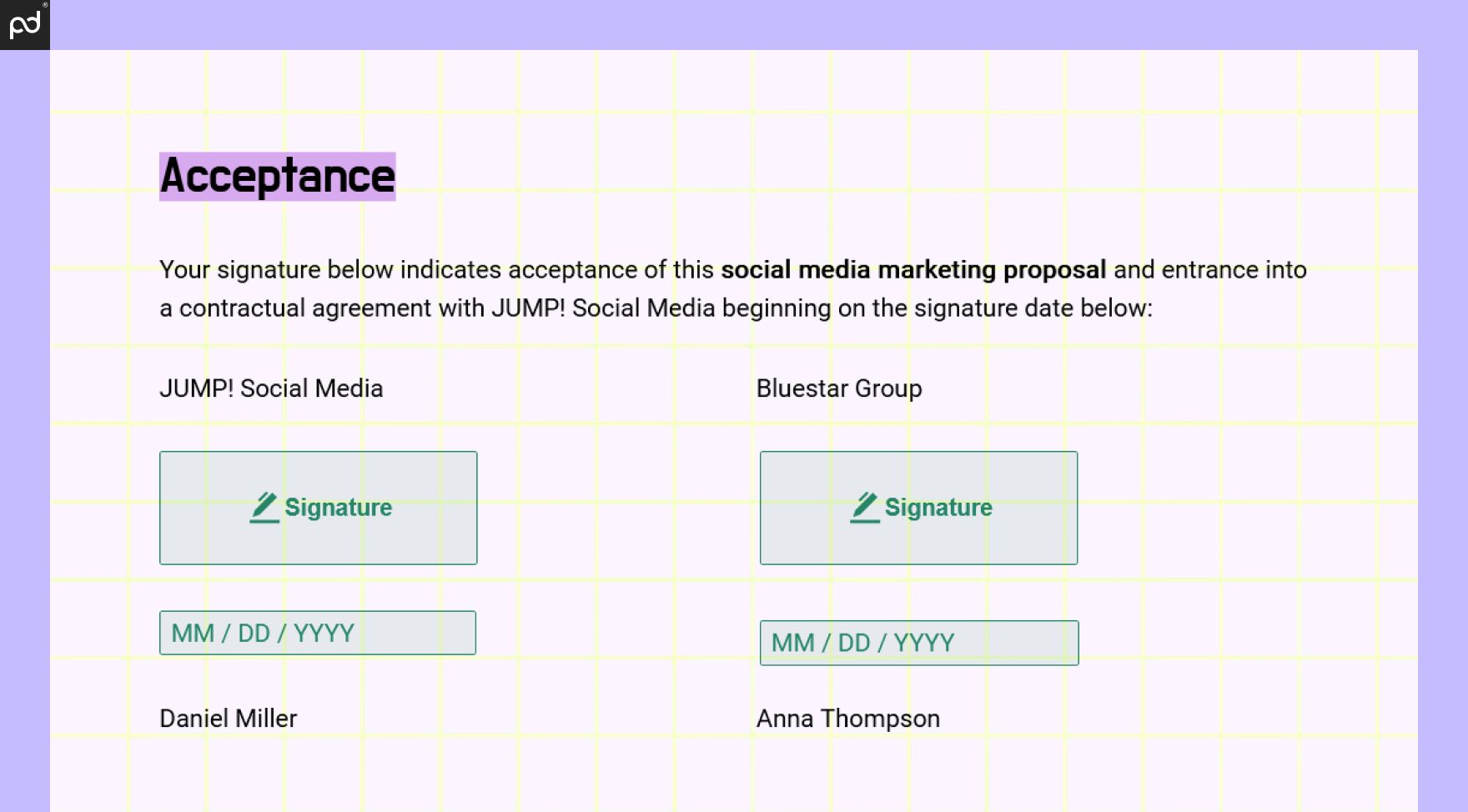
With onboard e-signing in your document, the call to action is often the signoff itself. If you choose not to include an e-signature, provide your contact information and instructions on next steps.
9. Agreement and CTA
Depending on your business proposal, you may include an agreement, a call to action, and terms and conditions at the end of your document.
Your signature below indicates acceptance of this social media marketing proposal and entrance into a contractual agreement with Jump Social Media Marketing beginning on the signature date below.
Depending on your goals and your sales process, you need to be very careful in this section.
In many jurisdictions, proposals are considered legally binding agreements if they meet the criteria for a contract.
By adding legal language and/or an electronic signature request at the bottom of your document, you might be entering into a contract earlier than expected.
This may not be ideal if your proposal is only intended to provide a rough estimate of costs or bring the client into further negotiations.
If you don’t intend to create a legally binding contract from your proposal, be sure to note that in your document and prompt the reader to contact you when they’re ready to move forward.
On the other hand, well-built proposals can double as complete contracts with all the terms and conditions necessary to start work immediately.
If you’re confident in the scope of work and you’re ready to move forward, let the client know by prompting them for a signature and using a payment gateway to capture their first payment or deposit.
How should a business proposal look?
First things first: We’re well past the turn of the century.
Nobody likes getting thick envelopes in the mail.
Modern business proposals are sent electronically, and this is more convenient for both you and your potential customers.
While it’s possible to email a proposal created with a word processor like Microsoft Word, platforms like PandaDoc are a better fit.
Our tools help you create a collaborative environment for negotiation, feedback, and electronic signature.
Regardless of how you choose to send a business proposal, be sure to pay close attention to the look and feel of your document.
Especially because your proposal may be your first impression with several key stakeholders, it’s essential that you follow expected formats and make a good impression.

Having the right design and layout tools can transform your proposal from a black-on-white Word document to a standout document that readers want to engage with.
Visuals
If you search for business proposal examples online or take a look at our template library, you’ll find that most proposals rely on the structure described above to emphasize their value propositions.
Taking care to create a visually appealing business proposal will help you communicate your ideas more easily.
It’s also something that your competitors are doing and something that many clients are beginning to expect.
In our research, we found that roughly 80% of proposals included an image and 20% included a video.
We also saw higher close rates when these multimedia tools were used compared to when they weren’t.
Exactly how a business proposal is designed still has some flexibility, depending on your brand and what you’re trying to achieve, but keep in mind that it can have a big impact on success.
Business proposals with pages of blocky text are much harder to navigate than proposals with charts, graphs, images, and bullet points.
Rather than writing a 1000-word About Us section, consider including team member headshots and a brief bio.
Rather than adding highly technical language about operational processes and leaving stakeholders to figure it out, provide visual aids that summarize the information in a clear and easy fashion.
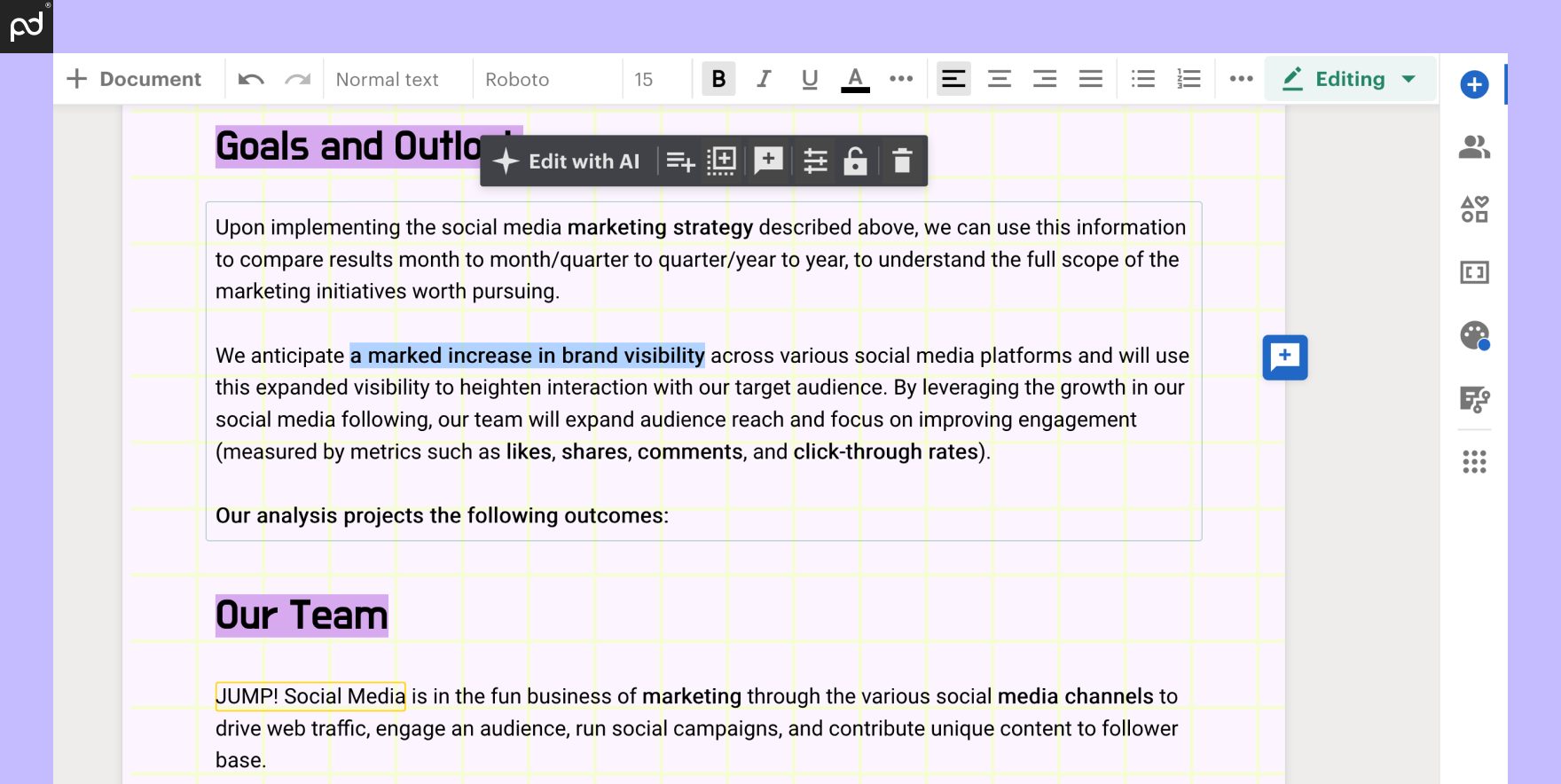
Generating personalized content quickly improves relevance and helps your team clearly define a scope of work. Onboard formatting and AI tools inside the PandaDoc platform can help.
Writing
Clearly defining your milestones isn’t the only reason to pay careful attention to how your business proposal is written.
While there can be legal ramifications to poorly written proposal content, perhaps the most important consideration is the impression that your proposal leaves behind.
Your proposal introduces your client to the quality of work they can expect from your business.
If it’s full of typos, spelling, and grammatical errors, or just seems sloppy, you’re unlikely to close the deal.
Read and re-read. Be sure to proofread every passage for errors before you send it to prospective clients or save it as a template.
You can also offset some of this tedium, especially on smaller deals, by focusing on creating a concise offering rather than a long-winded document.
A word about costs
When you’re creating proposals, it’s easy for costs to add up.
Costs for customized professional business proposals can take hours of research, consultation, and preparation — all with no guarantee of success.
That’s why savvy companies do everything they can to lower the cost of proposal preparation.
Typically this is done by generating a template for business proposals — an outline or skeleton that someone can fill out quickly to save time and expedite internal company processes.
It’s an effective way to keep overhead low.
Based on our research, an average of 20 documents are generated from each template you create.
That’s a huge time saver for any business.
If these aren’t assets that you have on your staff, consider hiring that skillset onto your team or hiring a freelancer to assist with proofreading and correction.
While many clients will overlook a stray typo or a misplaced comma, too many errors will land your proposal in the discard pile.
After you hit ‘Send’ on your business proposal
Once you’ve sent your proposal, your next step will depend on the process.
Based on our information, about 65% of business proposals containing a signature block close within 24 hours.

Even for proposals that take a little longer to close, having an e-signature block and collaboration options inside an interactive document means that review, redlining, and signoff happen in one place.
However, your mileage may vary. RFPs tend to be competitive processes, so you may have to wait until the submission window closes before you hear a response.
Don’t forget to follow up and ask your potential client if they have any questions.
Based on the business proposals we looked at, you are 30% more likely to close a deal if you send a series of reminders to keep your proposal top of mind.
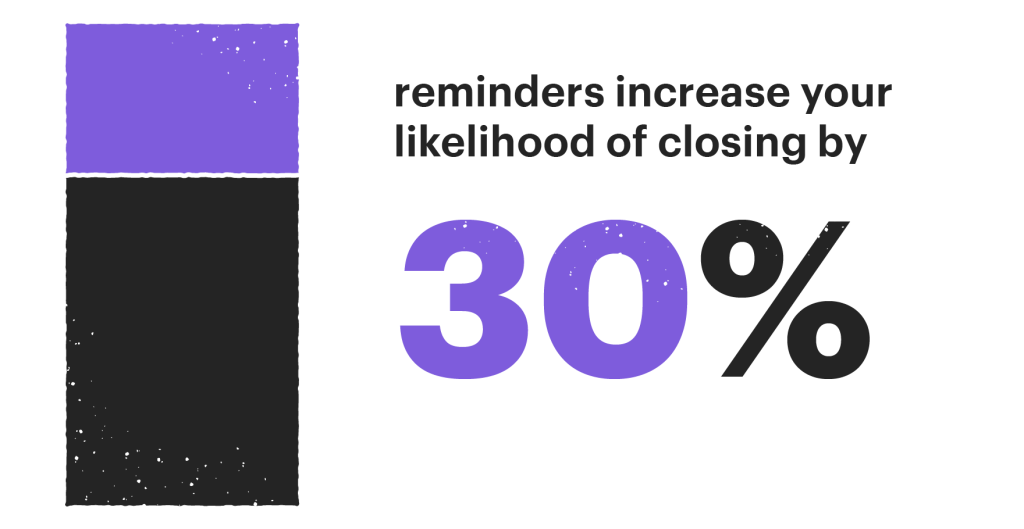
Roughly one out of every three proposals you send will close faster if you send reminders. It’s a big deal.
PandaDoc and other proposal software tools can help you monitor your proposal using document analytics so that you know exactly when to reach out.
These tools let you know when your potential client viewed your proposal, how many times they opened it, and which sections they spent the most time on.
With these insights, you can anticipate their questions or objections and have your responses ready to go.
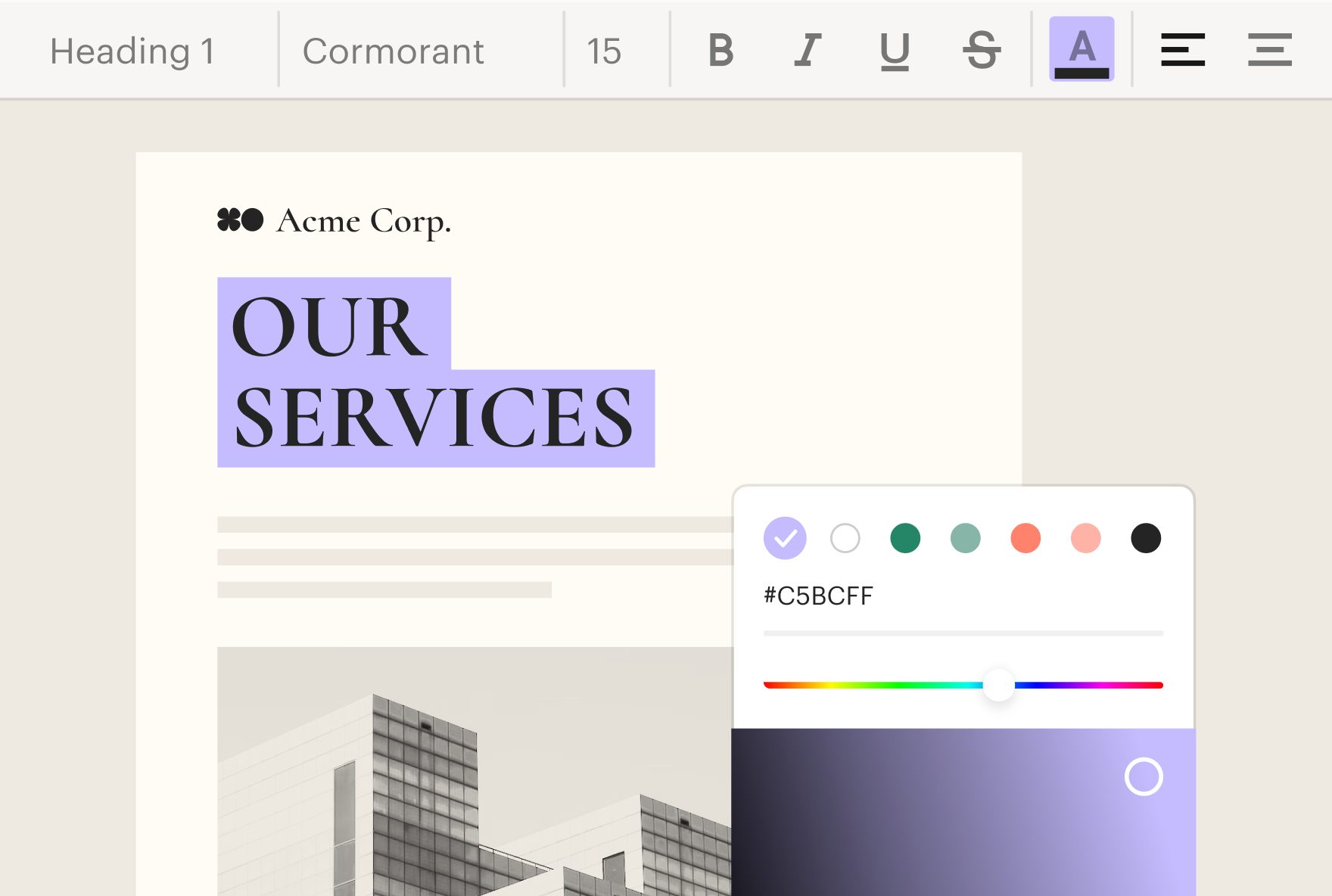
A great proposal is a blend of text and modern design. Personalization is as much about how your document looks as about what it says.
5 ideas to make your business proposal stand out
Just because you may have a perfect business proposal all ready to go, it doesn’t mean it will stand out from the crowd.
Many startups fail due to larger competitors, so a unique proposal idea can make your readers sit up and take notice.
Pizazz isn’t what matters here, rather any idea that adds value to your proposal and communicates quality.
Here are a few ideas to put the spotlight on your business proposal.
Personalize your proposal for each client
Ensure that your business proposal meets the exact challenges and interests of each recipient, as this will show you understand their specific needs.
Send a digital proposal
While you may need to send a business proposal as a PDF, include a link to a digital copy of the proposal where potential clients can review content, ask questions, and collaborate with your team.
A tool like this will give your recipient access to additional resources and make your proposal interactive.
Add a video introduction
As part of the personalization process, create a memorable experience by recording a brief video introduction.
Small touches like this can help your proposal stand out by demonstrating that you’re willing to do a little more to grab their attention.
Provide effective visual aids
Charts, graphs, and other visual aids are game-changers when it comes to creating effective documents.
Whether you need to present a specific data set or pricing breakdown, take the time to use visuals when the opportunity presents itself.
Readers will thank you for it.
Hide a few Easter eggs
A hidden message, cute animation, or a secret section are all little surprises that add a touch of fun and intrigue to your business proposal.
Easter eggs can encourage exploration and will encourage your readers to spend more time on your proposal.
It won’t be one they’ll forget in a hurry!
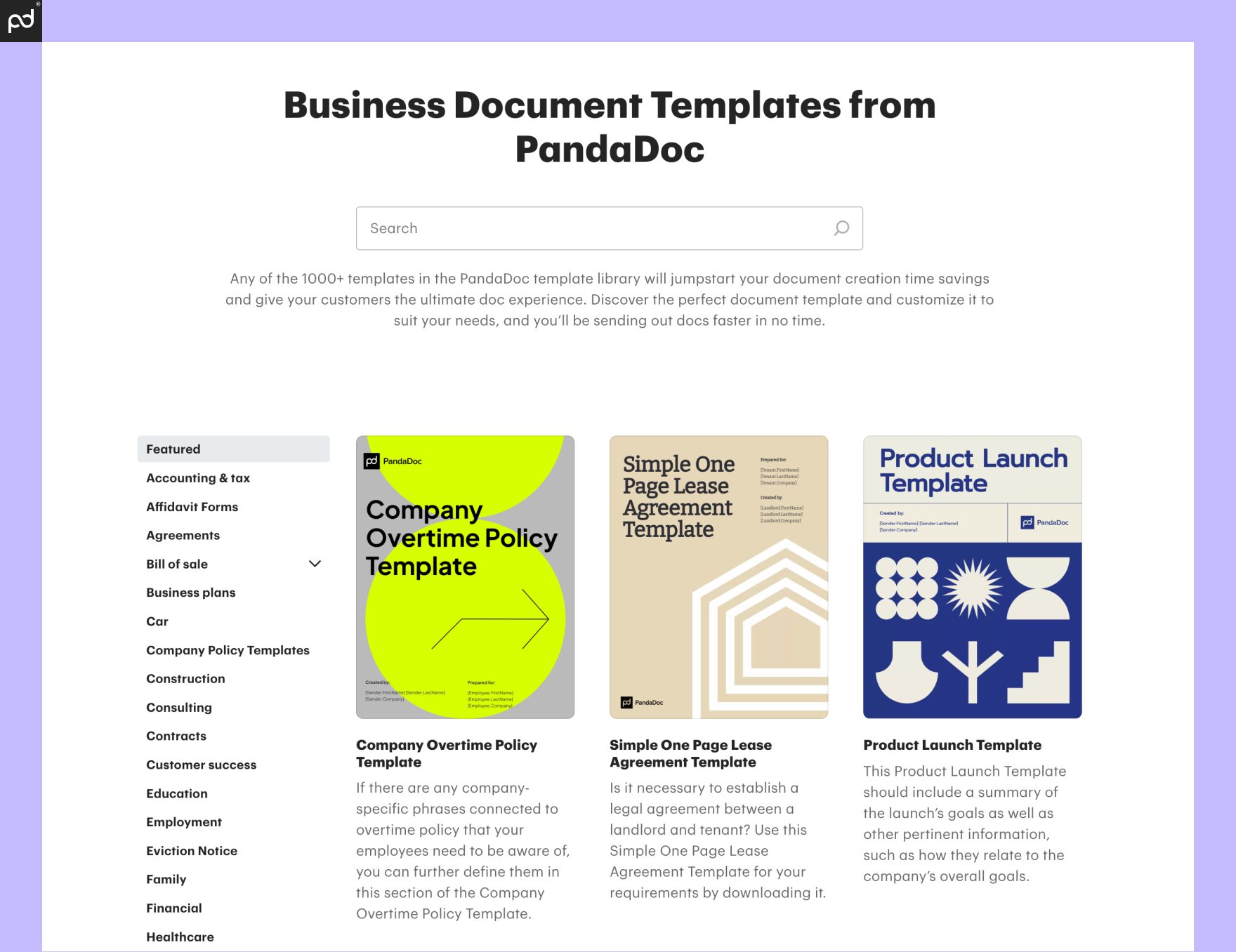
Jumpstart your proposal creation process with one of 1000+ documents in the PandaDoc template library.
Start with a free business proposal template
Need to know how to write a business proposal but don’t know where to begin? PandaDoc can help with some great templates.
In the data we reviewed, proposals created using our business proposal templates regularly generated high-performing results for customers with minimal editing time.
Take a look at some of the metrics around the top professional business proposal templates currently in our template library.
With PandaDoc, it’s possible to modify our existing templates and then save them as new, private templates in your content library for faster reuse.
In doing so, you can slim the entire business proposal design process down from hours to minutes or spend more time refining your proposal for maximum appeal.
To see the true power of the PandaDoc editor, be sure to check out our community gallery for expertly designed templates from real PandaDoc customers.
If you’re a PandaDoc user, you can even grab these business proposals and load them directly into your PandaDoc editor with a single click.
It’s just that easy.

PandaDoc can dramatically increase your proposal output, allowing you to send custom proposals to more customers in less time.
Use specialized tools to streamline your workflow
Ultimately, your proposal should be focused on your client’s problems and how your business plans to fix them.
But that doesn’t mean you have to do it alone.
Personalizing documents and tailoring them to a client’s needs is a time-consuming process.
For most businesses, striking a balance between personalization and efficiency is essential.
PandaDoc makes document creation fast and easy with 1,000+ ready-to-use templates and a simple drag-and-drop editor. Whether you’re building proposals, quotes, or contracts, everything’s designed to streamline your workflow from start to send.
Send smarter documents. Close deals faster.
Try it free for 14 days or book a demo to see how PandaDoc can transform the way you work.
Disclaimer
PandaDoc is not a law firm, or a substitute for an attorney or law firm. This page is not intended to and does not provide legal advice. Should you have legal questions on the validity of e-signatures or digital signatures and the enforceability thereof, please consult with an attorney or law firm. Use of PandaDocs services are governed by our Terms of Use and Privacy Policy.
Originally published April 2024, updated November 7, 2025
